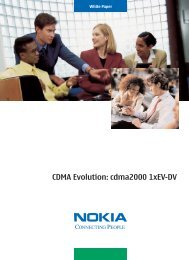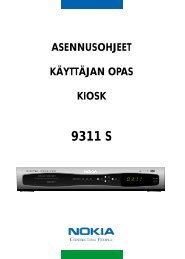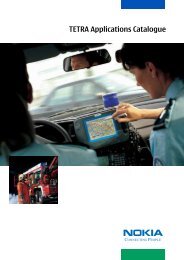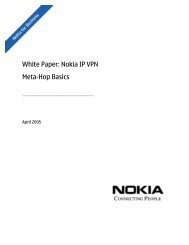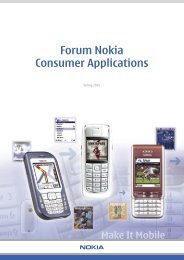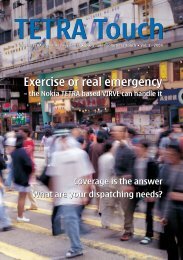Nokia Environmental Report 2002
Nokia Environmental Report 2002
Nokia Environmental Report 2002
Create successful ePaper yourself
Turn your PDF publications into a flip-book with our unique Google optimized e-Paper software.
<strong>Environmental</strong> <strong>Report</strong> <strong>2002</strong><br />
S T A K E H O L D E R R E L A T I O N S<br />
Good for the producer, the consumer and the environment<br />
Tom Parker of Interel has worked for the Electronics<br />
Coalition that came together in 1998 to work on the<br />
proposed EU directives on Waste Electrical and Electronic<br />
Equipment (WEEE) and the Restriction of the Use of Certain<br />
Hazardous Substances in Electrical and Electronic Equipment<br />
(RoHS).<br />
<strong>Nokia</strong> was one of the founders of the Electronics Coalition,<br />
which identified four key areas of concern in relation to<br />
the proposed directives:<br />
• Producer responsibility<br />
• Industry responsibility for historic waste<br />
• Responsibility for free riders and orphan products.<br />
(Orphan products are products whose producer is<br />
no longer in business; free riders are companies that<br />
evade producer responsibility for example through<br />
entering and leaving the market quickly.)<br />
• Looking at substance legislation from a sound<br />
scientific perspective<br />
When the first ideas for the directives were circulated<br />
back in 1998 the majority of the industry argued that<br />
there should be flexible producer responsibility providing<br />
for either individual or collective responsibility, depending<br />
on the circumstance or, for example, the type of<br />
product in question.<br />
Parker says the companies in the Electronics Coalition<br />
understood that if you make a company responsible for<br />
the recycling and material content of its own products,<br />
the company has an incentive to go back and rethink how<br />
it could reduce recycling costs through better product<br />
design.<br />
17<br />
“<strong>Nokia</strong> understood right from the beginning that if<br />
there were a free choice between collective and individual<br />
responsibility, the large majority of companies would<br />
choose collective responsibility, leading eventually to a<br />
situation where there would exist no driving forces for<br />
better design,” Parker notes.<br />
The Electronics Coalition was successful in first of all<br />
forming consensus around individual producer responsibility<br />
within industry. Then the coalition played a central<br />
role in convincing the European Parliament that this was<br />
the right approach to take. Once the parliament had<br />
accepted the coalition’s position, a lot of work went into<br />
convincing the other institutions, the Council and the<br />
European Commission. The European Parliament and the<br />
Council reached final agreement in November <strong>2002</strong> that<br />
for consumer products, producer responsibility should be<br />
on an individual basis.<br />
Tom Parker stresses that if good and environmentally<br />
responsible product design is rewarded through lower<br />
recycling costs, then it ultimately becomes interesting for<br />
the consumer to buy products that are better for the<br />
environment.<br />
“What we are confronted with in many cases today is that<br />
those products that are better for the environment are the<br />
more expensive ones and a lot of consumers cannot<br />
therefore afford to choose them even if they want to. The<br />
ultimate objective is that those products that are easier to<br />
recycle and better for the environment are cheaper. In this<br />
way, there is a benefit for the producer, for the consumer<br />
and for the environment.”






